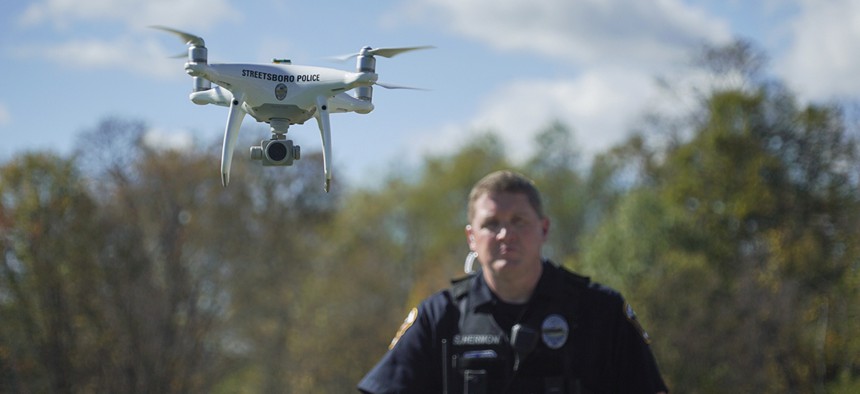Drones Take Off in a Public Safety Role

Streetsboro Officer Scott Hermon pilots the department's first drone in Streetsboro, Ohio. Dake Kang/AP
Will successful rescue missions completed with the help of drone operators help loosen some of the FAA's regulations?
John Breeden II is an award-winning journalist and reviewer with over 20 years of experience covering technology. He is the CEO of the Tech Writers Bureau , a group that creates technological thought leadership content for organizations of all sizes. Twitter: @LabGuys
Last year, as the drone-flying craze was taking off, I wrote a column about the advantages of drones in a public safety role. At the time, my home was completely snowed in, and the prospect of using drones to help people in need—or even as reconnaissance for emergency workers to know what roads were accessible—seemed like a clever idea.
At the time, not many states were considering using drones in official roles. Only a few, mostly western states like Utah with large tracts of public land, were really embracing drones, going so far as to support a civilian auxiliary corps of drone flyers who could be called upon to assist with search and rescue operations.
The federal government, through the Federal Aviation Administration, has been less than helpful in encouraging the use of drones by civilians or even emergency personnel. Like with many new technologies, the initial government response was to try and over-regulate it. For the most part, the FAA historically saw little difference between drone aircraft and actual airplanes, and set up many no-fly zones for drones in various parts of the country for assorted reasons.
They do get kudos,however, for creating the B4UFLY mobile app for both the Apple iOS and Android platforms . B4UFLY is one of the best federal apps ever created. It uses overlay maps to show drone restrictions across the country. You can even file a flight plan with the app, and it will notify you if any special permissions are needed given the area you plan to traverse with your drone.
Drones have joined in searches for missing hikers lost in the wilderness and have had some success. But last week, they achieved perhaps their most dramatic save yet, locating a confused elderly woman who had wandered away from her home in North Carolina. A drone located the woman after just 25 minutes of searching, something that might have alternatively taken hundreds of ground-based volunteers. Check out the dramatic video of the last few minutes of the search.
There are a few things to note about that video. First off, spotting the woman crouched down in the cornfield is extremely easy from above using the drone. Secondly, the woman notices the drone and pushes her hood up, almost as if she is trying to hide from it. She obviously was not in a state of mind to be able to help with her own rescue. Finally, at the very end, notice that the two officers who eventually find her are looking in two different places. Even just a couple corn rows away, they couldn’t find the lost woman and had to be directed to her by the drone’s pilot. Without the drone, searchers could have walked right past her, and she might never have been found.
Apparently, the Randolph County Sheriff’s Office in North Carolina is at the forefront of drone technology use. Captain Bernie Maness told Reuters that their department uses the drone frequently for everything from aerial crime scene photography to homicide investigations. It even once chased a fleeing suspect.
My hope is that drone successes like the one in North Carolina will help to thaw the resistance toward drones at the FAA. Closer to home, the FAA has implemented one of the most restrictive airspaces anywhere in the world, which includes drones. Called the “National Defense Airspace,” Washington is governed by a Special Flight Rules Area (SFRA) put in place to restrict flying in a 30-mile radius around Ronald Reagan Washington National Airport. The FAA has been heavily promoting this policy , even making No Drone Zone posters for the area.
However, even in this bastion of anti-drone sentiment, the rules are lessening up a bit. Recently, the FAA has changed the SFRA into two zones for drones, adding a 15-mile inner ring to house the original no-fly restrictions. Outside of 15 miles, but within the 30-mile radius, drone piloting is now allowed with the following common-sense restrictions.
- Drones must weigh less than 55 lbs. (including any attachments such as a camera).
- Aircraft must be registered and marked.
- Fly below 400 ft.
- Fly within visual line-of-sight of the operator.
- Fly in clear weather conditions.
- Never fly near other aircraft.
Those restrictions make sense and are a lot fairer than the blanket no-fly rule the FAA had in place before. Most drone pilots that I know are extremely responsible people who self-follow similar safety guidelines, even in areas with no restrictions.
Being able to rescue someone using a drone like what happened in North Carolina is probably every pilot’s dream. As successes like that one continue, hopefully, the FAA will also keep evolving, and eventually see drones for the fun and interesting hobby, and potentially life-saving tool, that they are in the hands of a dedicated pilot.






